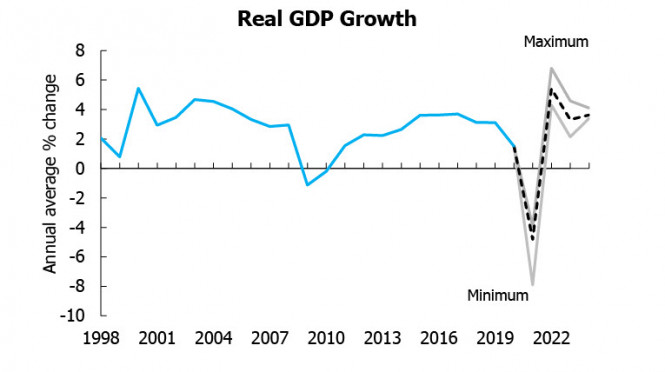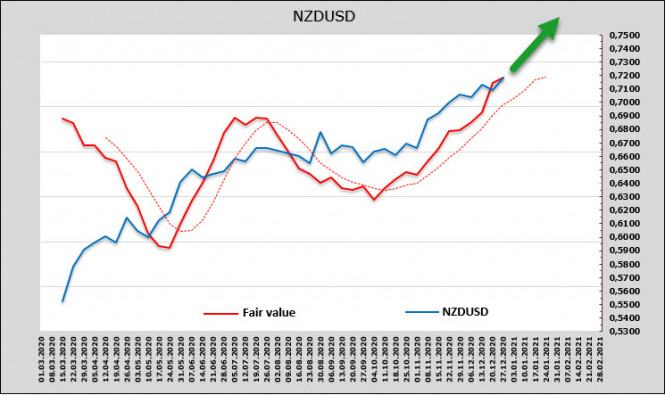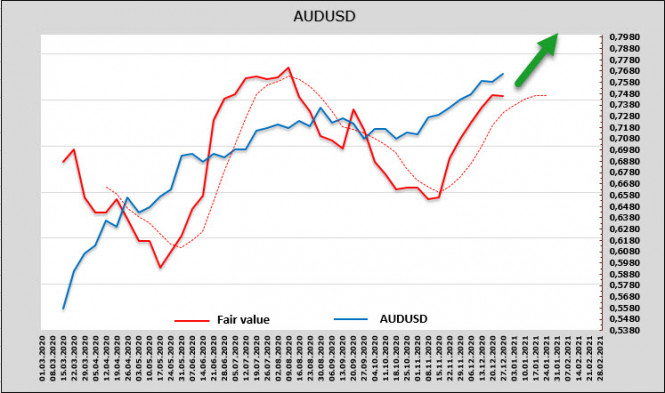US stock indices closed at record levels due to the signing of the $ 2.3 trillion economy and government spending bill. The rising optimism led to the growth of stock indices in the Asia-Pacific countries and February Brent futures, which is positively supported by the API report on the decline of stocks.
In general, the markets are positively rising, while the US dollar will remain under pressure.
NZD/USD
The New Zealand dollar has a good chance of continuing growth in the medium term. The latest NZIER consensus forecasts show a significant upward revision in almost all significant macroeconomic parameters, which suggests a recovery in the form of a V-shaped graph. This was not expected in the summer for either the US or European countries.
Initially, a significant increase in demand is expected as a reaction to RBNZ's stimulus measures. In particular, the wage subsidy scheme, increased social benefits and lower mortgage rates have boosted housing demand and retail spending. Rising expectations for consumer demand led to a higher inflation forecast, while a recovery in business confidence and an increase in the intention to hire more employees led to a lower forecast for unemployment.

NZIER also believes that increasing capacity utilization will lead to faster wage growth, and since New Zealand's economy has proven more resilient to stress than expected, concerns about the introduction of a negative RBNZ rate are reduced.
The latter situation is probably the key to the reorientation of financial flows. The CME net long speculative position remains confidently bullish. The target price continues to rise, so the growth of NZD/USD pair on the spot is absolutely logical.

On the other hand, a number of secondary forecasts do not fall out of the general trend – it is expected that annual growth of private consumption will grow by 7.2% until March 2022. The uncertainty about exports has declined, whose forecast for 2021 is revised upwards. Here, investment in construction is expected to rise by 8%.
Everything indicates that the New Zealand dollar will be in demand, especially amid high uncertainty over the US economic recovery. This morning, the price of NZD/USD overcame the resistance level of 0.7166 and reached the two and a half year high of 0.7185. The strategic goal of the bulls is to consolidate above the resistance level of 0.7560, which will mean a reversal of the long-term trend. And although the NZD might fail on the first attempt, growth towards this key resistance is still possible in the next few weeks.
AUD/USD
The Australian dollar also has a good chance to continue rising. The net short position for the reporting week declined by 372 million. In general, the situation is neutral with a slight bullish advantage. The target price is above the long-term average, so the trend remains bullish.

Contrary to New Zealand, Australia's economy is complicated by growing tensions with China. Diplomatic communication between the two countries at the ministerial level and above has been suspended for more than a year. From China's viewpoint, Australia is the most consistent supporter of the United States in the sanctions war against China, despite the fact that China is its largest trading partner.
In view of this, tensions with China are the main factor preventing Australia from benefiting from a changing external environment that can support its economy. At the same time, Biden's victory in the US election increases the chances of additional stimulus, which means an expected increase in commodity prices.
COVID-19 risk in Australia is lower than other Northern countries, due to approaching summer and low seasonal activity of the virus.
Technically, the AUD/USD pair has no serious resistance up to the level of 0.8136, so the most logical strategy is to hold long positions in the short-term, buy on pullbacks and ignore small fluctuations.
The material has been provided by InstaForex Company - www.instaforex.com